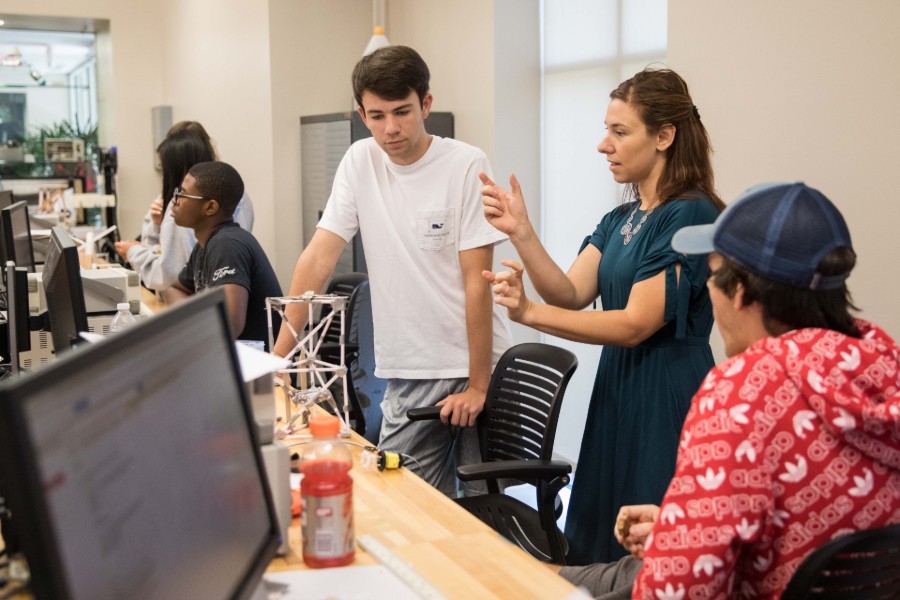Lipscomb faculty member presents to supercollider scientists
Scientists at the world’s largest and most powerful particle collider, the Large Hadron Collider, in Switzerland, heard from a Lipscomb engineering professor this fall at the annual conference for CERN, the European Organization for Nuclear Research.
Janel Shoun-Smith |

Stephanie Weeden-Wright’s research specialty focuses on the effects of radiation on the reliability of electronics.
Stephanie Weeden-Wright, professor of electrical and computer engineering practice in the Raymond B. Jones College of Engineering, was invited to the Topical Workshop on Electronics for Particle Physics, the annual gathering of all the scientists who conduct experiments for CERN, to present on the latest in miniaturized innovative circuits.
The CERN scientists were interested in this topic because the supercollider is scheduled for an update in the next 5 five to 10 years, and the electronics currently being used are far out of date, Weeden-Wright said.
The CERN organization contacted Vanderbilt University’s Institute for Space and Defense Electronics, where Weeden-Wright holds a dual faculty appointment, to invite them to do a presentation on their work with state-of-the-art miniaturized innovative circuits. The institute suggested that Weeden-Wright, make the presentation.
The Hadron Collider is the largest single machine in the world and was built between 1998 and 2008 by a collaboration of 10,000 scientists and engineers from more than 100 countries, as well as hundreds of universities and laboratories. The Hadron collider is where Nobel prize-winning physicists confirmed the existence of the Higgs Boson particle.
CERN uses the world's most complex scientific instruments to study the basic constituents of matter–the fundamental particles. The particles are made to collide together at close to the speed of light. The process gives the physicists clues about how the particles interact, and provides insights into the fundamental laws of nature.
“It was very exciting to be able to share some of my communities’ research with the engineers and physicists attending; I never thought I'd be doing anything like this,” Weeden-Wright said. “It was a great honor to collaborate with a community of scientists and engineers that are working on some very interesting problems!”
Weeden-Wright’s research specialty focuses on the effects of radiation on the reliability of electronics. For example, electronics used in outer space are constantly bombarded by particles, causing noise and failures, Weeden-Wright said. It is often too expensive to shield the electronics with heavy lead, so scientists are exploring creative ways to protect electronics, she said.
“Radiation effects have applications beyond space and defense,” said Weeden-Wright. “Companies like Intel and Texas Instruments have scientists dedicated to ensuring their commercial consumer electronics are not affected by our terrestrial radiation environment.” Electronics in the supercollider deal with much more radiation than cell phones or tablet computers are exposed to, but the research of Weeden-Wright and her colleagues is one step toward the new generation of electronics the supercollider will need, she said.
The Vanderbilt Institute for Space and Defense Electronics is one of the largest university-based research institutes on the subject of radiation effects and reliability in miniaturized innovative circuits.
In her research, Weeden-Wright straddles experimentation and theory and uses a lot of simulation tools, she said.
“I’m trying to bring simulation into the classroom at Lipscomb,” she said. “In upper-division classes we talk about really complex devices like transistors that are only a couple of nanometers across. It’s very difficult to understand how these things work, so having these computerized tools to be able to visualize them and play around with their reality, helps you see how the device will behave.”
Weeden-Wright received her Bachelors of Science in Physics from Seattle University and her Ph.D. from Vanderbilt University where she specialized in radiation hardening of emerging memory technologies. Throughout her graduate tenure she was a visiting research scientist at NASA AMES research center and USC ISI Disruptive Electronics group.
Before joining Lipscomb Engineering, Weeden-Wright was an instructor at the School for Science and Math at Vanderbilt. For the past two years, alongside three Ph.D. scientists, she developed and implemented experiential STEM curriculum for a novel interdisciplinary classroom environment.